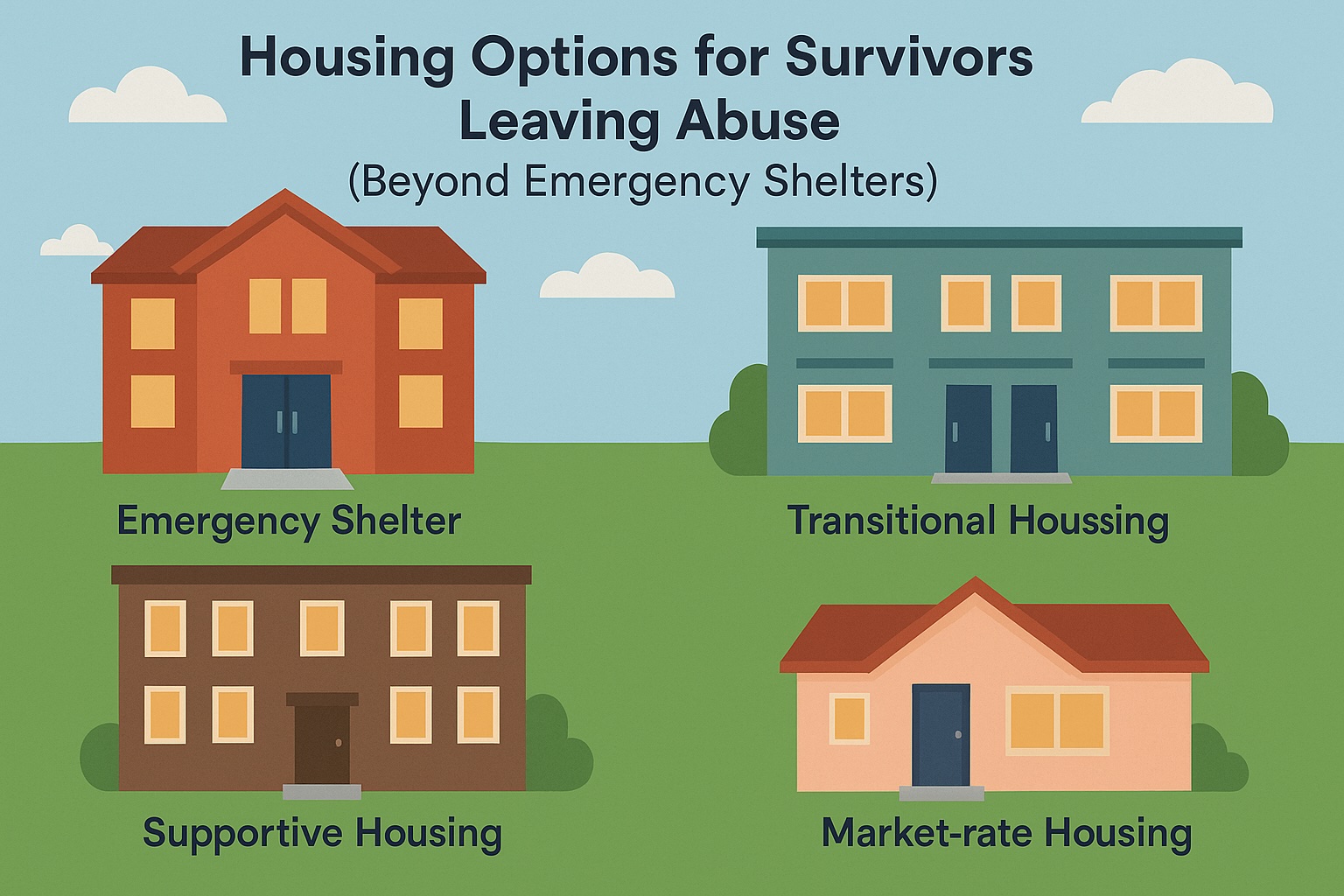Housing Options for Survivors Leaving Abuse (Beyond Emergency Shelters)
Leaving abuse is the first step—finding safe, stable housing is the next. This guide outlines transitional, subsidized, and long-term housing options for domestic violence survivors in Ontario.

Emergency shelters provide a critical first step for safety—but they’re not permanent solutions. Many survivors leaving abuse need longer-term housing options that are safe, affordable, and trauma-informed.
In Ontario, you have several non-shelter housing options designed specifically to support women and families escaping violence.
🏘️ 1. Transitional Housing
Temporary housing programs (6–24 months) for survivors
Often include on-site staff, safety planning, counselling, and legal help
Residents pay little or no rent while they stabilize and plan their next steps
Priority is given to women coming from shelters
Examples include:
YWCA Toronto
Interval House Second-Stage Housing
Nellie’s Transitional Housing
🏢 2. Subsidized and Supportive Housing
Rent-geared-to-income units for women and families fleeing abuse
Survivors are considered a priority group on waiting lists
Some programs include mental health or parenting supports
Apply through:
Housing Connections (Toronto)
Access to Housing (Hamilton)
Your local Service Manager (municipal housing authority)
🏡 3. Portable Housing Benefits (PHB – Special Priority)
A monthly housing subsidy to help you rent safely in the private market
Faster access under Ontario’s Special Priority Policy (SPP) if you are:
Leaving or have recently left an abusive situation
At risk of future harm from the abuser
Apply through your local housing provider or shelter with help from a worker
🔑 4. Community Housing Providers for Women
Feminist-led housing providers may offer safe, stable spaces for survivors
Often include:
Women-only environments
On-site staff trained in trauma support
Peer community programs
Look for providers such as:
WoodGreen Community Services
Homes First
Red Door Family Shelter Housing Program
🛏️ 5. Private Market Rentals (With Support)
With help from VQRP+ or Ontario Works, some survivors can access the private market
Emergency assistance may cover:
First and last month’s rent
Moving costs
Damage deposits
Always ask your DV shelter or support worker to help with applications
📦 6. Short-Term Safe Housing (Hotel or Motel Options)
Some shelters and victim services use motel overflow housing for short-term needs
Can be paired with case management and safety support
Common when shelters are full or if you require anonymity
VQRP+ may help cover the cost of these temporary stays
📌 Summary: Housing Options After Abuse
✅ Transitional housing offers extended support and time to rebuild
✅ Subsidized housing prioritizes survivors under SPP
✅ PHB helps rent in private market with monthly subsidy
✅ Women’s housing providers offer trauma-informed spaces
✅ Emergency funds can cover rent deposits and moving costs
📍 Ontario Resources
Assaulted Women’s Helpline – 1-866-863-0511
211 Ontario – Call 211 or visit 211ontario.ca
Legal Aid Ontario – 1-800-668-8258
Your Local Women’s Shelter – Ask for housing worker or referrals
Victim Services – Help with VQRP+ and emergency accommodation
Frequently Asked Questions (FAQs)
1. What is the difference between an emergency shelter and transitional housing?
An emergency shelter is for immediate, short-term safety, typically for a few weeks. Transitional housing (or second-stage housing) is a longer-term solution, offering accommodation for 6-24 months with intensive supports to help you prepare for permanent independence.
2. How do I get "Special Priority" status for subsidized housing in Ontario?
To qualify for the Special Priority Policy (SPP), you must show that you have ended your cohabitation with an abusive partner within the last three months. You will need to fill out a specific application, and a support worker from a women's shelter or a similar agency can help you complete the required documentation.
3. What is a "Portable Housing Benefit" (PHB)?
A PHB is a monthly payment that helps you afford rent in the private market. Unlike a subsidized housing unit, the benefit is "portable," meaning it's tied to you, not a specific apartment. You can take it with you if you move, as long as you remain eligible.
4. I've found an apartment but can't afford the first and last month's rent. Where can I get help?
You can apply for emergency financial assistance. The Victim Quick Response Program+ (VQRP+) can often help cover these costs for victims of crime. You can also apply for emergency funds through your local Ontario Works (OW) office.
5. I'm afraid of living alone. Are there safer options?
Yes. Look into housing provided by women-led organizations. These buildings often have enhanced security and on-site staff who are trained in trauma-informed support, creating a safer and more understanding community environment.
6. How do I apply for these housing programs?
The best first step is to connect with a support worker at your local women's shelter. They are experts in navigating the housing system and can help you determine which options you are eligible for, assist with all the application forms, and advocate on your behalf.
